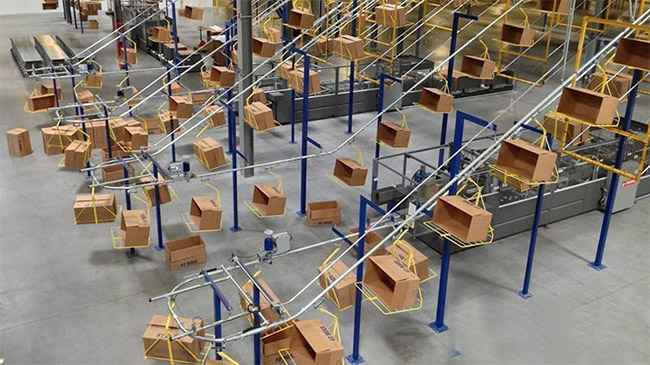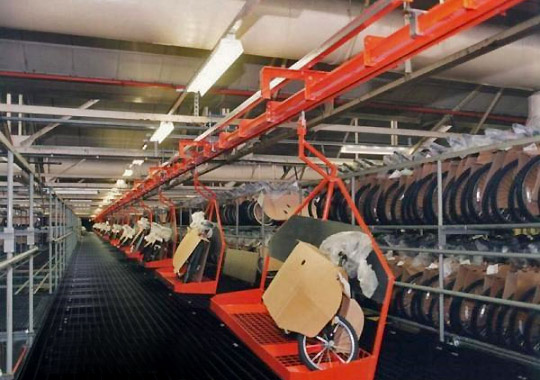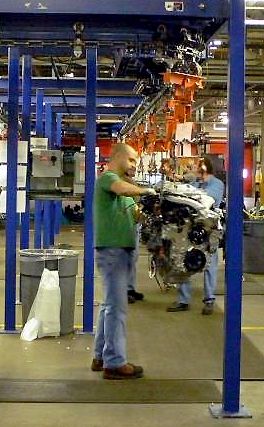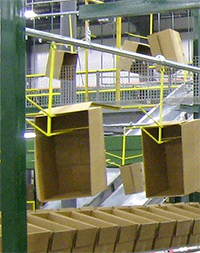When to Transport Loads with Overhead Conveyor Systems
Loads to consider include awkward components, assembly lines, empty boxes and more

Overhead conveyors are an efficient way to transport products on an assembly line or in a distribution facility. For the right load in the right situation, they’re the most economical and efficient way to convey products. What are some of the characteristics of a good overhead load?
The definition of an overhead conveyor
Belt and roller conveyors are frequently installed above the ground to free up floor space, for safety, to cross obstacles or other reasons. On a conventional conveyor, the load sits on a belt or rollers. These conveyors aren’t “overhead” systems even though they’re off the ground. With true overhead conveyor systems, loads are suspended on task-specific carriers and are conveyed along a rail system. We’ll touch a bit on suspended belt and roller systems, but this article focuses on task-specific overhead conveyors that utilize rail systems and hangers.
Overhead conveyors can be manual or powered and use a single rail to transport the load. They follow a single continuous path, which can be very long (hundreds or thousands of feet) and can easily and fluidly change directions vertically or horizontally.
Convey the things they say can’t be conveyed
There are some loads that are considered impossible to convey. This may be because the load can’t rest on a flat surface, because the conveyor can’t handle a tough environment (caustic chemicals, paint, etc.), because the temperatures are too extreme or when human handling might cause issues with the load. So when should you consider an overhead system?
When the load can’t easily sit on a conveyor

Above: carriages for unbalanced loads.
When your load is odd-shaped, unbalanced or difficult to seat, there may be challenges resting on a flat belt or rollers. Some loads have distributed weights that could damage them if sat flat. There are certainly ways to deal with that, including bowtie rollers for pipes, or cleats that can contain certain shapes, but those may not apply to your product. With an overhead conveyor, the load’s shape and ability to rest on a surface is largely irrelevant, since it can be suspended in a carrier or from a line made just for it.
Use overhead systems when the load must be manipulated during the process

We see this in paint lines; the spray must reach every corner of the load, so it can’t sit on any surface. But this can also be a factor for progressive assembly in operations where workers may need to access the top, bottom and all sides. For some applications, this can be achieved with a conventional belt or roller conveyor and workstation hoists or balancers, but it may be less expensive and easier with a suspended load. Overhead systems allow people to work on the load at ergonomically correct elevations.
Balancers and hoists may provide more precise control of the load (raising or lowering it, or spinning it in place in some instances). This depends on the operation and load characteristics for any situation.
Right: progressive assembly utilizing overhead conveyors
Overhead systems are ideal for harsh environments
Difficult environments are tough on all machinery–including conveyors. Overhead systems can transport the loads through harsh environments like caustic washers, spray or paint application booths and very hot drying and baking ovens.
Extreme temperatures: Obviously, people cannot work in most areas where extreme temperatures. For conveying purposes, overhead systems are often more tolerant of heat than flat a belt or roller systems (think ovens, drying booths, etc).
Paint booths: This is a common application for overhead conveyors, which allow you to suspend the load for better paint coverage.
Caustic chemicals & other substances: You should remove human interaction with these areas as much as possible. Overhead conveyors are ideal for transporting a component through such environments without damaging the load or causing an overload of cleaning and maintenance.
Trash and empty box conveying

In many distribution centers, split case picking is frequently used for order fulfillment. In these operations, cartons are emptied, and the next carton rolls forward to replace it. Order pickers must then dispose of the empty box. Whether your workers accumulate boxes or dispose of them immediately, empties have to be dealt with. There are a few ways to do this.
- If the box is to be flattened or trashed, flat-surface trash conveyors can convey it. These conveyor lines work, but can offer some space utilization challenges. For boxes you’d like to keep, or if you don’t want your people flattening them on the line, overhead systems may be the better option.
- Operators can dispose of the box manually (either by stacking it near the work area, or walking it away to trash, reuse or recycling areas). In high-volume situations, this can be a productivity drain. You can assign someone to collect cartons manually, or use order pickers for the job. Either way, time is being expended to deal with the debris.
- You can use an overhead conveyor, which may be the most common choice. Either overhead or flat conveyors can deliver the empties to your carton building or recycling area, allowing order pickers to mostly ignore empty boxes. Overhead systems can run parallel to your picking conveyors to occupy the minimum of space necessary.
Conveyors can also be used to deliver fresh boxes to a packing area in some operations. When it comes to conveying, we have seen it done either with overhead or flat belt conveyors. Space and outcomes are usually the deciding factors.
Types of overhead conveyors
- Enclosed track: This system runs its continuous chain through a tubular track powered by a drive. The chain is kept tense by a take-up, which prevents it from bunching up. The whole line moves when the drive is engaged, meaning that all the loads move at the same pace and distance from each other. Loads are suspended from pendants that protrude from a narrow slot, and can carry up to 50 pounds each (you can convey a load weighing as much as 100 pounds from two pendants). Enclosed tracks are extremely compact. Common applications include assembly lines, buffer storage for work-in-process, empty cartons and paint lines.
- Heavy-duty enclosed tracks operate like enclosed tracks, but can handle heavier loads–up to 220 pounds per pendant or 440 pounds in dual-pendant situations. Capacity diminishes if the track is slotted upwards or sideways.
- Power and free systems: Sometimes these are called asynchronous systems, since loads can travel at different speeds using a powered chain track set above a gravity track that holds trolleys. Pushers move the trolleys. Unlike track systems, your loads can stop and go independently, which makes them ideal for work-in-process applications, production lines and parts buffering for manufacturing facilities. They can stop the load at workstations to allow work to be executed on the load, then let it move to the next stage. With an overhead system, tracks can change when you need them to. They’re adept at integration with multiple lines, diverts, merges, sortation and accumulation. They handle capacities of 220 or 440 pounds in standard configurations. You can mount them either suspended from the ceiling or on structural floor supports.
- I-beam monorail systems run on heavy-duty trolleys and offer the highest capacity ratings of any overhead conveyor type (ranging from 200 pounds per trolley to 1,200 pounds depending on the configuration; with a load bar, you can double those capacities). Use i-beam systems in tough, industrial environments, and when you have heavy motors, dies or other components. Good for paint and finishing lines.
Final thoughts
There are options on how to convey almost any item that can include overhead, belt, roller or low-profile options, and it can usually be done with standard systems and components, if designed and implemented correctly. If you need help finding a way to transport, buffer or store products correctly, let us know.
Scott Stone is Cisco-Eagle's Vice President of Marketing with 35 years of experience in material handling, warehousing and industrial operations. His work is published in multiple industry journals an websites on a variety of warehousing topics. He writes about automation, warehousing, safety, manufacturing and other areas of concern for industrial operations and those who operate them.



